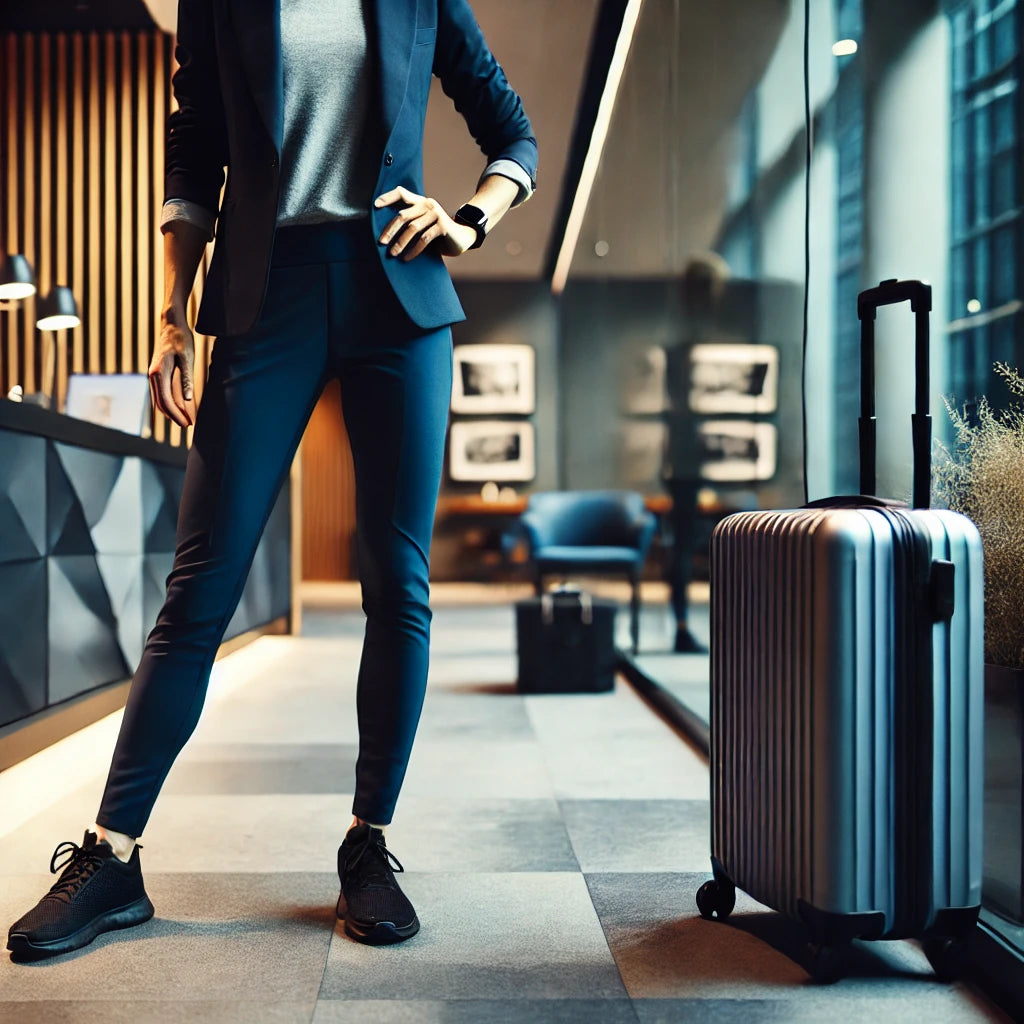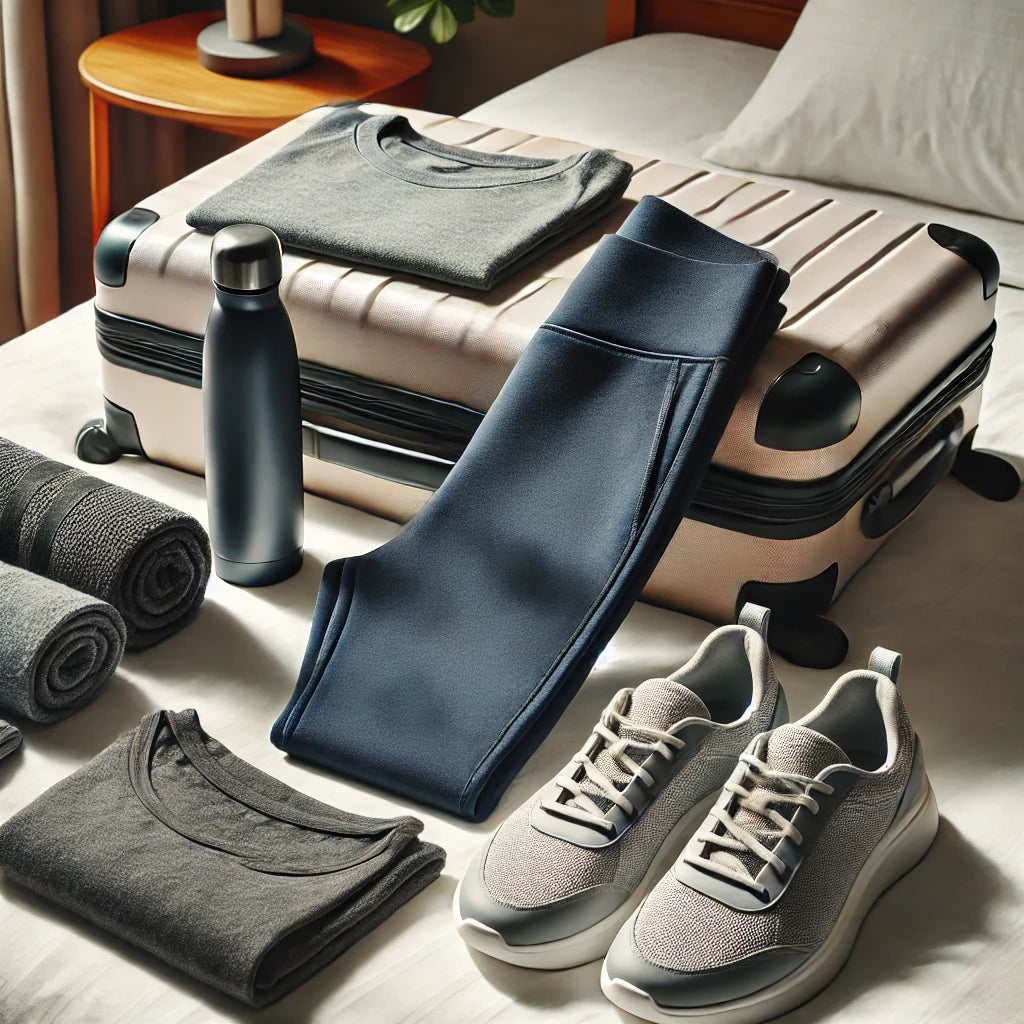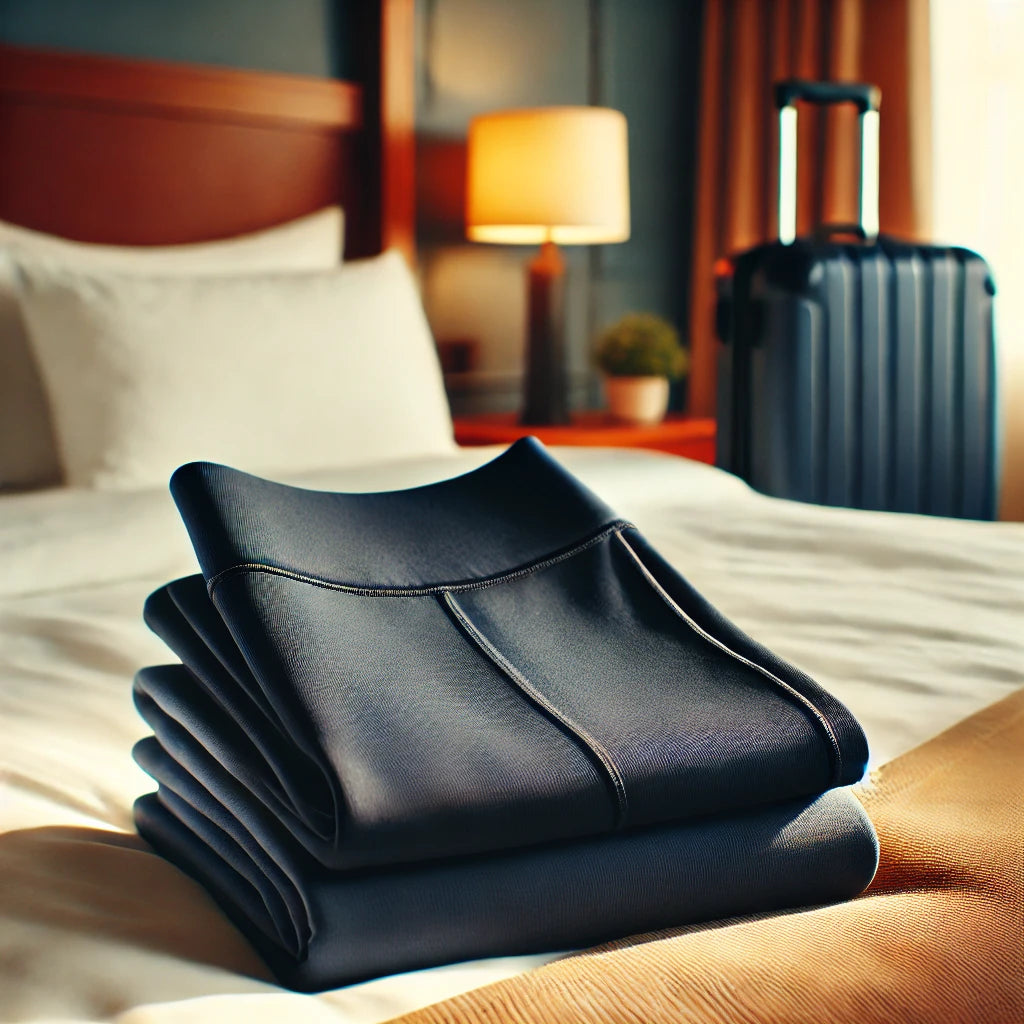In today's fast-paced world, finding time to stay fit can be a challenge, especially for traveling professionals constantly on the move. Whether you're a pilot, flight attendant, or travel nurse, maintaining a consistent workout routine is crucial for your health and well-being. Fortunately, 24/7 workout routines offer the flexibility to exercise anytime, anywhere, without the need for a gym. In this blog post, we'll explore effective 24/7 workout routines designed to keep you fit, no matter your schedule or location. From hotel rooms to layover lounges, discover how you can stay active and healthy on the go.

The Importance of Staying Fit for Traveling Professionals
Traveling professionals often face unique challenges when it comes to maintaining their fitness routines. Irregular schedules, long working hours, and constant travel can disrupt regular workout habits and lead to a sedentary lifestyle. However, staying fit is essential for several reasons:
- Health and Well-being: Regular exercise is vital for maintaining physical and mental health. It helps reduce the risk of chronic diseases, improves cardiovascular health, and enhances overall well-being.
- Energy and Productivity: Exercise boosts energy levels and improves productivity. For professionals with demanding schedules, staying active can lead to better performance at work.
- Stress Management: Travel and work-related stress can take a toll on mental health. Regular physical activity is a proven way to manage stress, improve mood, and enhance mental clarity.
- Quality of Sleep: Exercise promotes better sleep, which is crucial for recovery and overall health. For professionals who travel frequently, maintaining good sleep patterns can be challenging but is essential for long-term health.
Designing Effective 24/7 Workout Routines
To create effective 24/7 workout routines, it’s important to focus on exercises that require minimal equipment and can be performed in various environments, such as hotel rooms, airports, or small outdoor spaces. The following components are essential for a well-rounded fitness routine:
- Strength Training: Building and maintaining muscle mass is important for overall strength, metabolism, and bone health. Bodyweight exercises, resistance bands, and portable weights are excellent options.
- Cardiovascular Exercise: Cardio workouts improve heart health and endurance. Activities such as running, brisk walking, jumping jacks, and burpees can be done anywhere.
- Flexibility and Mobility: Stretching and mobility exercises enhance flexibility, prevent injuries, and improve overall movement quality. Yoga and dynamic stretches are ideal.
- Core Workouts: A strong core is essential for balance, stability, and overall strength. Exercises like planks, Russian twists, and bicycle crunches can be performed without equipment.
Sample 24/7 Workout Routines
Routine 1: Hotel Room Workout
Warm-up (5 minutes):
- Jumping jacks: 1 minute
- High knees: 1 minute
- Arm circles: 1 minute
- Leg swings: 1 minute
- Bodyweight squats: 1 minute
Strength Training (20 minutes):
- Push-ups: 3 sets of 12-15 reps
- Bodyweight squats: 3 sets of 15-20 reps
- Tricep dips (using a chair): 3 sets of 12-15 reps
- Lunges: 3 sets of 12-15 reps per leg
- Plank: 3 sets of 30 seconds
Cardio (10 minutes):
- Burpees: 30 seconds on, 30 seconds off (repeat for 10 minutes)
Flexibility and Mobility (5 minutes):
- Forward fold stretch: 1 minute
- Cat-cow stretch: 1 minute
- Downward dog: 1 minute
- Seated forward bend: 1 minute
- Child’s pose: 1 minute
Routine 2: Airport Layover Workout
Warm-up (5 minutes):
- Marching in place: 1 minute
- Arm swings: 1 minute
- Standing side bends: 1 minute
- Toe touches: 1 minute
- Gentle jog in place: 1 minute
Strength Training (20 minutes):
- Incline push-ups (using a bench or chair): 3 sets of 12-15 reps
- Step-ups (using a bench or sturdy surface): 3 sets of 15 reps per leg
- Seated leg lifts: 3 sets of 15 reps
- Wall sits: 3 sets of 30 seconds
- Plank shoulder taps: 3 sets of 20 taps
Cardio (10 minutes):
- High knees: 30 seconds on, 30 seconds off (repeat for 10 minutes)
Flexibility and Mobility (5 minutes):
- Standing quad stretch: 1 minute per leg
- Standing hamstring stretch: 1 minute per leg
- Shoulder stretch: 1 minute per arm
- Neck stretch: 1 minute
Routine 3: Outdoor Park Workout
Warm-up (5 minutes):
- Light jog: 2 minutes
- Arm circles: 1 minute
- Walking lunges: 1 minute
- Dynamic stretches: 1 minute
Strength Training (20 minutes):
- Pull-ups (using a playground bar or tree branch): 3 sets of 8-10 reps
- Push-ups: 3 sets of 12-15 reps
- Bulgarian split squats (using a bench): 3 sets of 12-15 reps per leg
- Bench dips: 3 sets of 12-15 reps
- Bicycle crunches: 3 sets of 20 reps
Cardio (10 minutes):
- Sprint intervals: 30 seconds sprint, 30 seconds walk (repeat for 10 minutes)
Flexibility and Mobility (5 minutes):
- Pigeon pose: 1 minute per leg
- Standing calf stretch: 1 minute per leg
- Overhead tricep stretch: 1 minute per arm
- Spinal twist: 1 minute per side
Tips for Staying Consistent
Consistency is key to reaping the benefits of a fitness routine. Here are some tips to help you stay consistent with your 24/7 workout routines:
- Plan Ahead: Schedule your workouts in advance and treat them as non-negotiable appointments. Planning ensures that you make time for exercise despite a busy schedule.
- Set Realistic Goals: Set achievable fitness goals that are specific, measurable, and time-bound. Having clear goals keeps you motivated and focused.
- Stay Flexible: Be adaptable and ready to modify your workouts based on your environment. If you can’t do a full workout, even a shorter session is better than none.
- Track Your Progress: Keep a workout journal or use a fitness app to track your progress. Seeing improvements over time can boost motivation and provide a sense of accomplishment.
- Stay Accountable: Share your fitness goals with a friend or join an online fitness community. Accountability partners can provide support, encouragement, and motivation.
- Listen to Your Body: Pay attention to how your body feels and adjust your workouts accordingly. Rest when needed and avoid overtraining to prevent injuries.
Nutrition and Hydration Tips for Traveling Professionals
In addition to exercise, proper nutrition and hydration are crucial for maintaining fitness and overall health. Here are some tips for traveling professionals:
- Pack Healthy Snacks: Carry nutritious snacks such as nuts, seeds, fruit, protein bars, and whole grain crackers. These are convenient and can help you avoid unhealthy airport or hotel food options.
- Stay Hydrated: Drink plenty of water throughout the day. Carry a reusable water bottle and refill it regularly. Dehydration can impact energy levels and overall well-being.
- Balanced Meals: Aim for balanced meals that include lean proteins, complex carbohydrates, healthy fats, and plenty of fruits and vegetables. This ensures you get essential nutrients and maintain energy levels.
- Limit Processed Foods: Minimize the consumption of processed and fast foods. These often contain high levels of unhealthy fats, sugars, and sodium.
- Mindful Eating: Practice mindful eating by paying attention to hunger and fullness cues, avoiding distractions while eating, and savoring your food.
- Plan Ahead: Research restaurants and grocery stores at your travel destination. Planning ahead can help you make healthier food choices.
Overcoming Common Challenges
Traveling professionals may face several challenges when it comes to maintaining a fitness routine. Here are some common challenges and strategies to overcome them:
- Limited Time
- Solution: Opt for shorter, high-intensity workouts such as HIIT, which can be effective in a short amount of time. Utilize breaks and downtime for quick exercise sessions.
- Lack of Equipment
- Solution: Focus on bodyweight exercises that require no equipment. Resistance bands are also lightweight and portable, making them ideal for travel.
- Irregular Schedules
- Solution: Be flexible with your workout timing. Fit in exercise whenever you have a free moment, whether it’s early morning, late at night, or during a layover.
- Fatigue
- Solution: Listen to your body and rest when needed. Prioritize quality sleep and recovery to ensure you have the energy for your workouts.
- Lack of Motivation
- Solution: Set clear goals, track your progress, and find ways to stay accountable. Remind yourself of the benefits of staying active and the positive impact on your health and well-being.
Incorporating Technology into Your Fitness Routine
Technology can be a valuable tool for staying fit on the go. Here are some ways to incorporate technology into your 24/7 workout routines:
- Fitness Apps: Use fitness apps to access guided workouts, track your progress, and stay motivated. Popular apps include MyFitnessPal, Strava, and Nike Training Club.
- Online Workout Videos: Follow workout videos on platforms like YouTube, which offer a wide variety of routines for different fitness levels and preferences.
- Wearable Fitness Trackers: Wearable devices like Fitbit or Apple Watch can track your activity, heart rate, and sleep patterns, providing valuable insights into your fitness progress.
- Virtual Personal Training: Consider virtual personal training sessions for personalized guidance and support. Many trainers offer online coaching that can be done from anywhere.
- Health and Wellness Apps: Use apps focused on nutrition, hydration, and stress management to complement your fitness routine and maintain overall health.
Real-Life Success Stories
Hearing about the success of others can be inspiring and motivating. Here are a few real-life success stories of traveling professionals who have managed to stay fit despite their busy schedules:
- Sophia the Flight Attendant
- Sophia, a flight attendant, struggled to find time for exercise with her erratic schedule. She started following 24/7 workout routines that she could do in her hotel room. By focusing on bodyweight exercises and yoga, she improved her fitness levels, managed her stress better, and felt more energetic during flights.
- John the Pilot
- John, a commercial pilot, used to feel constantly tired and out of shape due to his demanding job. He began incorporating quick HIIT workouts during layovers and packed healthy snacks to avoid unhealthy airport food. Within months, he lost weight, gained muscle, and experienced a significant boost in his overall health and energy levels.
- Emma the Travel Nurse
- Emma, a travel nurse, found it challenging to maintain a consistent workout routine. She started using fitness apps to access guided workouts and track her progress. By doing short, high-intensity workouts and staying committed to her fitness goals, Emma maintained her strength and stamina despite her hectic travel schedule.

Customizing Your 24/7 Workout Routine
Everyone’s fitness needs and goals are different, so it’s important to customize your 24/7 workout routine to suit your individual preferences and limitations. Here are some tips for personalization:
- Identify Your Goals
- Determine what you want to achieve with your fitness routine, whether it’s building muscle, losing weight, improving cardiovascular health, or enhancing flexibility.
- Assess Your Fitness Level
- Start with exercises that match your current fitness level and gradually increase the intensity as you build strength and endurance.
- Choose Exercises You Enjoy
- Incorporate exercises and activities that you enjoy to make your workouts more enjoyable and sustainable.
- Consider Your Environment
- Adapt your workouts to the available space and equipment. For example, if you’re in a hotel room, focus on bodyweight exercises, while outdoor spaces can be great for running or interval training.
- Listen to Your Body
- Pay attention to how your body responds to different exercises and adjust accordingly. Avoid pushing yourself too hard and ensure you get adequate rest and recovery.
Advanced Training Techniques
For those who are already fit and looking to challenge themselves further, incorporating advanced training techniques can help take your fitness to the next level. Here are some techniques to consider:
- Supersets
- Perform two exercises back-to-back with minimal rest. This increases the intensity and efficiency of your workout.
- Drop Sets
- Perform an exercise to failure, then reduce the weight and continue for more reps. This technique is great for building muscle.
- Pyramid Training
- Start with a low weight and high reps, gradually increasing the weight and decreasing the reps. This method can enhance both strength and endurance.
- Circuit Training
- Combine multiple exercises into a circuit with little to no rest between each exercise. This keeps your heart rate up and provides a comprehensive workout.
- Tempo Training
- Manipulate the speed of your lifts, focusing on slow, controlled movements to increase time under tension and maximize muscle growth.
Importance of Recovery and Rest
Recovery is a critical component of any fitness routine, especially for traveling professionals who may be dealing with jet lag, irregular sleep patterns, and physical fatigue from constant travel. Here are some recovery strategies to incorporate:
- Prioritize Sleep
- Ensure you get enough quality sleep each night. Establish a consistent sleep schedule, even when traveling, to support recovery and overall health.
- Active Recovery
- Include low-intensity activities such as walking, stretching, or gentle yoga on rest days to promote blood flow and reduce muscle soreness.
- Hydration
- Stay hydrated to support muscle recovery and overall bodily functions. Dehydration can hinder recovery and lead to fatigue.
- Nutrition
- Consume a balanced diet with adequate protein, carbohydrates, and fats to support muscle repair and recovery. Include anti-inflammatory foods to reduce muscle soreness.
- Foam Rolling and Massage
- Use foam rollers or get massages to release muscle tension and improve circulation. This can help speed up recovery and prevent injuries.
- Listen to Your Body
- Pay attention to signs of overtraining such as persistent fatigue, decreased performance, and increased susceptibility to illness. Rest when needed and avoid pushing yourself too hard.
Mental Health and Fitness
Maintaining mental health is just as important as physical health, especially for traveling professionals who may face stress and burnout. Here are some strategies to support mental well-being:
- Mindfulness and Meditation
- Practice mindfulness and meditation to reduce stress and improve mental clarity. Even a few minutes of daily meditation can have significant benefits.
- Stay Connected
- Maintain social connections with friends, family, and colleagues. Social support can provide emotional stability and reduce feelings of isolation.
- Set Realistic Expectations
- Set achievable goals and avoid putting too much pressure on yourself. Recognize that maintaining fitness while traveling can be challenging, and it’s okay to adjust your routine as needed.
- Engage in Enjoyable Activities
- Incorporate activities that you enjoy and that bring you joy and relaxation. Hobbies and leisure activities can provide a mental break from work.
- Seek Professional Help
- If you’re struggling with mental health issues, don’t hesitate to seek help from a mental health professional. Therapy and counseling can provide valuable support.

Adapting Workouts to Different Environments
As a traveling professional, you often find yourself in various environments that may not be conducive to traditional workouts. However, with a bit of creativity, you can adapt your routines to fit almost any setting. Here’s how you can tailor your workouts to common environments you might encounter:
Hotel Room Workouts
Hotel rooms can be limited in space, but there are plenty of exercises that can be done within the confines of a small room.
Upper Body Exercises
- Push-Ups: Variations such as standard push-ups, incline push-ups (using the bed or a chair), and decline push-ups can provide a comprehensive upper body workout.
- Tricep Dips: Use a sturdy chair or the edge of the bed to perform tricep dips.
Lower Body Exercises
- Bodyweight Squats: A foundational move that targets the legs and glutes.
- Lunges: Perform forward, backward, and lateral lunges to engage different muscles.
- Step-Ups: If you have access to a stable chair or bench, step-ups are great for building leg strength.
Core Exercises
- Planks: Hold a plank position on the floor to engage the core. Variations include side planks and plank shoulder taps.
- Russian Twists: Sit on the floor with your knees bent, lean back slightly, and twist your torso from side to side.
Airport Workouts
Layovers can be long and tiresome, but they also offer an opportunity to get some exercise. Look for less crowded areas where you can move freely.
Full-Body Workouts
- Dynamic Stretching: Start with dynamic stretches to warm up your muscles. These include arm swings, leg swings, and torso twists.
- Walking: Airport terminals are usually spacious enough for a brisk walk. Walking is a great way to get your steps in and stay active.
- Bodyweight Exercises: Perform squats, lunges, and calf raises to keep your muscles engaged.
- Resistance Band Exercises: Carry a resistance band in your bag for a portable workout. Use it for bicep curls, shoulder presses, and leg extensions.
Outdoor Workouts
If you have access to a park or open space, outdoor workouts can be refreshing and invigorating.
Cardio
- Running or Jogging: Utilize trails or sidewalks for running or jogging. Interval training can add intensity to your cardio session.
- Jump Rope: A jump rope is portable and provides a high-intensity cardio workout.
Strength Training
- Pull-Ups: If the park has pull-up bars, incorporate them into your routine. They are excellent for upper body strength.
- Park Bench Exercises: Use a park bench for step-ups, tricep dips, and elevated push-ups.
Flexibility and Balance
- Yoga: An open grassy area is perfect for a yoga session. Focus on poses that improve flexibility and balance.
- Tai Chi: Practice Tai Chi for a low-impact, meditative workout that enhances balance and coordination.
Advanced Techniques for Maximizing Results
For those looking to intensify their workouts and achieve specific fitness goals, incorporating advanced techniques can be highly beneficial. Here are some methods to consider:
High-Intensity Interval Training (HIIT)
HIIT alternates between intense bursts of activity and fixed periods of less-intense activity or even complete rest. It’s highly effective for burning calories and improving cardiovascular health.
Sample HIIT Routine
- Warm-Up: 5 minutes of light jogging or brisk walking
- Intervals: 30 seconds of sprinting followed by 1 minute of walking (repeat 10 times)
- Cool-Down: 5 minutes of light jogging or brisk walking
Supersets
Supersets involve performing two exercises back-to-back with no rest in between. This method keeps the heart rate elevated and maximizes workout efficiency.
Example Superset Routine
- Push-Ups and Planks: Perform a set of push-ups immediately followed by a plank hold.
- Lunges and Squats: Perform a set of lunges followed by bodyweight squats.
Drop Sets
Drop sets involve performing an exercise to failure, then reducing the weight and continuing for additional reps. This technique is excellent for muscle hypertrophy.
Example Drop Set Routine
- Dumbbell Bicep Curls: Start with a weight you can lift for 8-10 reps, then reduce the weight by 20% and continue until failure. Repeat with another weight drop.
Pyramid Training
Pyramid training involves gradually increasing (or decreasing) the weight and number of reps in a set pattern. It’s effective for building strength and endurance.
Example Pyramid Routine
- Squats: Start with a light weight and 15 reps, increase the weight and perform 12 reps, continue increasing the weight and decreasing reps (10, 8, 6), then reverse the pattern.
Incorporating Technology for Enhanced Fitness
Technology can be a game-changer for staying fit on the go. Here are some ways to leverage technology to enhance your workout routines:
Fitness Apps
Numerous fitness apps offer guided workouts, tracking, and motivation. Some popular options include:
- MyFitnessPal: Tracks your diet and exercise, helping you maintain a balanced routine.
- Nike Training Club: Offers a wide range of workouts from yoga to HIIT, suitable for all fitness levels.
- Strava: Ideal for runners and cyclists, tracking your routes and performance.
Wearable Fitness Trackers
Wearable devices like Fitbits or Apple Watches can track your physical activity, monitor your heart rate, and even remind you to move.
- Activity Tracking: Monitors steps, distance, and calories burned.
- Heart Rate Monitoring: Helps you stay within your target heart rate zone.
- Sleep Tracking: Ensures you get adequate rest for recovery.
Virtual Workouts
Participating in virtual workouts can provide structure and motivation, especially when you’re away from home.
- Live Streaming Classes: Join live classes for a variety of workouts, from HIIT to yoga.
- On-Demand Videos: Access a library of workout videos that you can do at any time.
Online Personal Training
Virtual personal training offers personalized guidance and support from a fitness professional, regardless of your location.
- Custom Workout Plans: Receive tailored workout plans based on your goals and available equipment.
- Regular Check-Ins: Stay accountable with regular check-ins and progress assessments.
Maintaining Motivation and Consistency
Staying motivated and consistent can be challenging, especially with a demanding travel schedule. Here are some strategies to help you stay on track:
- Set Clear Goals
- Define what you want to achieve with your fitness routine. Having clear, achievable goals provides direction and motivation.
- Create a Routine
- Establish a regular workout schedule that fits your travel itinerary. Consistency is key to long-term success.
- Find a Workout Buddy
- Partner with a colleague or friend who shares your fitness goals. Having a workout buddy can increase accountability and make exercising more enjoyable.
- Reward Yourself
- Celebrate your achievements with small rewards. This positive reinforcement can help maintain motivation.
- Stay Flexible
- Be prepared to adjust your workouts as needed. Travel plans can change, so flexibility is essential for maintaining consistency.
- Keep a Fitness Journal
- Track your workouts, progress, and how you feel. Reflecting on your journey can provide motivation and highlight areas for improvement.
Addressing Common Challenges for Traveling Professionals
Traveling professionals often face unique challenges that can impact their fitness routines. Here are some common challenges and strategies to overcome them:
Jet Lag and Irregular Sleep Patterns
- Strategy: Try to maintain a consistent sleep schedule, even when crossing time zones. Use techniques such as light exposure, hydration, and avoiding caffeine or alcohol before bed to manage jet lag.
Limited Access to Healthy Food
- Strategy: Research healthy food options at your destination before you arrive. Pack nutritious snacks and consider using meal delivery services that offer balanced meals.
Stress and Burnout
- Strategy: Incorporate stress-relief activities such as meditation, deep breathing exercises, and leisure activities you enjoy. Regular exercise can also help manage stress levels.
Lack of Routine
- Strategy: Establish a flexible workout routine that you can adapt to different environments. Prioritize your health by scheduling workouts as non-negotiable appointments.
Injury and Overtraining
- Strategy: Listen to your body and avoid pushing yourself too hard. Include rest and recovery days in your routine, and seek medical advice if you experience persistent pain or discomfort.

Mindfulness and Mental Well-being
Maintaining mental well-being is crucial for overall health, especially for traveling professionals who may experience stress and burnout. Here are some mindfulness practices to incorporate into your routine:
Meditation
- Guided Meditation: Use apps or online resources for guided meditation sessions. These can help reduce stress and improve focus.
- Mindful Breathing: Practice deep breathing exercises to calm the mind and reduce anxiety. Inhale deeply, hold for a few seconds, and exhale slowly.
Journaling
- Daily Reflections: Spend a few minutes each day reflecting on your thoughts and experiences. Journaling can help process emotions and provide clarity.
- Gratitude Journaling: Write down things you are grateful for each day. This practice can enhance positivity and well-being.
Yoga and Tai Chi
- Yoga: Incorporate yoga into your routine for physical and mental benefits. Focus on poses that promote relaxation and stress relief.
- Tai Chi: Practice Tai Chi for a meditative and low-impact workout that improves balance and reduces stress.
Mindful Walking
- Nature Walks: Take walks in nature and pay attention to the sights, sounds, and smells around you. Mindful walking can be a powerful way to reduce stress and connect with your surroundings.
Digital Detox
- Limit Screen Time: Reduce your exposure to screens, especially before bedtime. Engage in activities that don’t involve screens, such as reading a book or spending time outdoors.
- Unplug Regularly: Take regular breaks from digital devices to reset and recharge your mind.
The Role of Professional Guidance
Working with fitness and health professionals can provide valuable guidance and support, especially for those with specific goals or health concerns. Here are some ways professionals can help:
Personal Trainers
- Customized Plans: Personal trainers can create customized workout plans based on your goals, fitness level, and available equipment.
- Technique and Form: They can ensure you are performing exercises correctly to prevent injuries and maximize effectiveness.
- Motivation and Accountability: Trainers provide motivation and accountability, helping you stay on track with your fitness goals.
Nutritionists and Dietitians
- Personalized Nutrition Plans: Nutritionists can develop personalized meal plans that support your fitness goals and dietary preferences.
- Nutritional Guidance: They can provide advice on nutrient timing, supplementation, and managing dietary restrictions.
Physical Therapists
- Injury Prevention and Recovery: Physical therapists can help prevent injuries and guide recovery from existing injuries.
- Mobility and Flexibility: They can recommend exercises to improve mobility and flexibility.
Mental Health Professionals
- Stress Management: Therapists and counselors can provide strategies for managing stress, anxiety, and other mental health concerns.
- Emotional Support: They offer a safe space to discuss and work through emotional challenges.
Community and Social Support
Building a community of like-minded individuals can provide additional motivation and support for your fitness journey. Here are some ways to engage with a fitness community:
Join Fitness Groups
- Local Clubs: Look for local running, cycling, or hiking clubs. Joining a group can make exercising more enjoyable and provide social interaction.
- Online Communities: Participate in online fitness communities and forums. These platforms offer support, advice, and a sense of camaraderie.
Participate in Events
- Fitness Challenges: Join fitness challenges or competitions to stay motivated and challenge yourself.
- Charity Runs and Walks: Participate in charity events that combine fitness with a good cause.
Share Your Journey
- Social Media: Share your fitness journey on social media to inspire others and receive encouragement.
- Fitness Blogs: Start a fitness blog to document your progress and share tips with others.
Encourage Others
- Support Friends and Family: Encourage your friends and family to join you in your fitness activities. Exercising together can strengthen relationships and provide mutual support.
By integrating these strategies and resources into your routine, you can create a comprehensive and sustainable fitness plan that adapts to your travel lifestyle. Staying fit anytime, anywhere is achievable with the right mindset, tools, and support.

Conclusion
Staying fit anytime, anywhere is entirely possible with the right approach and mindset. 24/7 workout routines offer the flexibility and convenience needed to maintain fitness despite a busy travel schedule. By incorporating a variety of exercises, staying consistent, and prioritizing overall health and well-being, traveling professionals can achieve and maintain their fitness goals. Remember, the key is to find a routine that works for you, stay adaptable, and enjoy the journey towards a healthier, more active lifestyle.
Read More
- Round-the-Clock Fitness: Workouts for Busy Professionals Available 24/7
- 24/7 Workout Plans: Staying Active and Fit Around the Clock
- Achieving Round-the-Clock Fitness: 24/7 Workout Routines for Busy Lifestyles
- Maintain Fitness Anytime, Anywhere with 24/7 Workouts
- Stay Fit Around the Clock: 24/7 Workout Tips for All Ages
- No Excuses: How to Incorporate Workouts 24/7 into Your Daily Schedule





